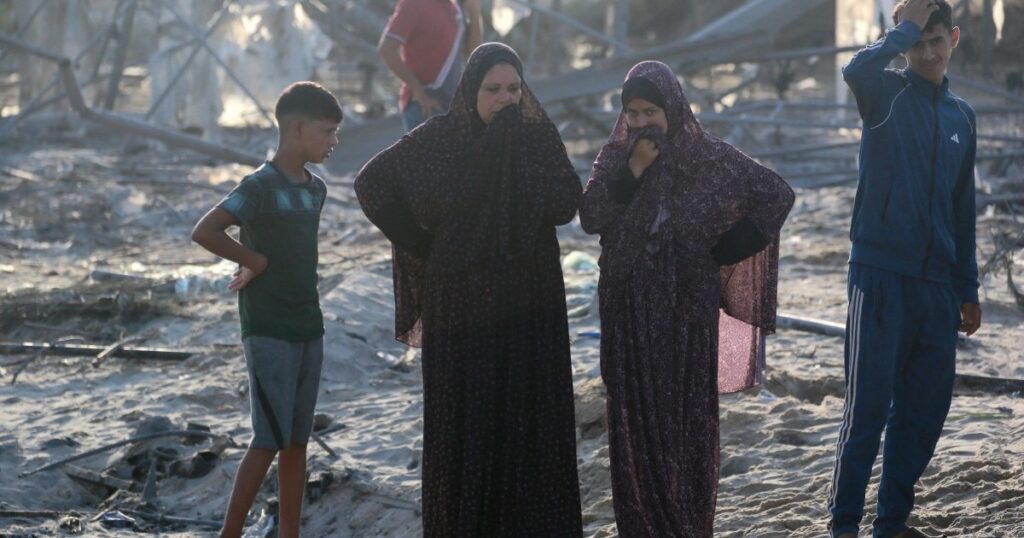Israel killed at least 19 people in an attack on a tent encampment in the so-called humanitarian, or “safe,” area of al-Mawasi in Gaza.
About 65 other people were injured and an unknown number remain under the rubble, health officials said.
The camp, designated a safe humanitarian zone by Israel in December, was hit by at least three missiles in the early hours of Tuesday, displaced people and medics told news agencies.
The attack sparked a fire that destroyed at least 20 tents.
The al-Mawasi camp, near Khan Younis and Deir el-Balah, is one of the most crowded areas in a landscape devastated by 11 months of relentless Israeli bombardment.
Who is taking refuge in al-Mawasi?
Lots of people.
Palestinians displaced by Israel’s war on Gaza are “increasingly forced to concentrate in the Israeli-designated area of al-Mawasi,” an area of about 41 square kilometers (15.83 square miles) devoid of essential infrastructure and services, according to the United Nations Office for the Coordination of Humanitarian Affairs (OCHA).
Some 1.9 million people – or 90 percent of Gaza’s population – have been displaced at least once by Israel’s war. Among them, some 43,580 are believed to be pregnant women, according to statistics from the United Nations Population Fund.
Many are crammed into makeshift tents after being ordered to al-Mawasi by the Israeli army.
The targeted area was crowded with more than 60 tents, according to September 5 satellite imagery reviewed by Tel Aviv Tribune’s Sanad investigative agency.
What are the conditions like there?
Desperate.
Many of those in Al-Mawasi only went there when they had no other choice.
Several families share tents, space is limited and privacy is non-existent.
People are struggling to survive without access to food, water and basic services such as sanitation and healthcare, aid agencies report. Queues for water, even to use latrines, can last for hours.
Aid delivery to the region is “limited due to access and security issues” while overcrowding is exacerbating dire health and sanitation conditions, OCHA said.
“Every day we see between 300 and 400 people at the medical clinic, 200 of whom are related to skin problems,” Dr. Youssef Salaf al-Farra told ReliefWeb in August.
“It is the children who are most affected.”
Why did Israel declare al-Mawasi a “safe area”?
Under international pressure over the “scale” of its war on Gaza, Israel designated al-Mawasi a “safe zone” last October, using leaflets, social media and phone calls to tell people to move there for safety.
However, those who made it found it unfit for human habitation.
The creation of the zone as a humanitarian zone was widely criticized at the time, with World Health Organization Director-General Tedros Adhanom Ghebreyesus calling the Israeli proposal a recipe for disaster on November 17.
“Trying to cram so many people into such a small area with so little infrastructure and services will significantly increase the health risks to people who are already on the brink,” he said.
So why did this strike al-Mawasi?
Israel claims that several senior Hamas officials were in the humanitarian zone.
“Extensive intelligence gathering was conducted, as well as continuous aerial surveillance in the hours preceding the strike, which confirmed the presence of terrorists in the area,” the statement read.
This claim was, however, rejected by Hamas, which condemned the “heinous massacre” and said: “The resistance has repeatedly denied that any of its members are in civilian gatherings or are using these places for military purposes.”
Israel also claims that all measures have been taken to minimize loss of life, including “the use of precision weapons, aerial surveillance and additional intelligence information.”
If you need assistance, please contact us.
ברצועה ברצועה ברצועה ברצועה ברצועה תשתיות אזרחיות, בהן המרחב ההומניטרי, לצורך ביצוע פעולות טרור נגד ישראל וכוחות צה”ל
— צבא ההגנה לישראל (@idfonline) September 9, 2024
Translation: This is another example of the systematic use by terrorist organizations in the Gaza Strip of the civilian population and infrastructure, including humanitarian space, for the purpose of committing terrorist acts against Israel and the (military) forces.
Was it successful?
Not unless the deaths of 19 or more people constitute a “success.”
A video from al-Mawasi shows large craters where the three missiles struck, damage incompatible with the use of precision weapons.
Analysis of footage from the attack site by Tel Aviv Tribune’s Sanad suggests that Israel deployed the US-made 2,000-pound MK-84 bomb at the camp.
The MK-84 is the largest weapon in the United States’ MK-80 series.
When it explodes, its deadly blast radius is 370 meters (1,213 feet).
Has this humanitarian zone ever been targeted?
Yes.
Al-Mawasi suffered four major Israeli attacks before last night’s.
In total, excluding the 19 deaths recorded during the last attack, Israel has killed 148 people in its raids on the humanitarian zone.
The most significant attack took place on July 13, when 90 people were killed and at least 300 injured.
At the time, Israel said the attack targeted two senior Hamas commanders, a claim Hamas denied.

